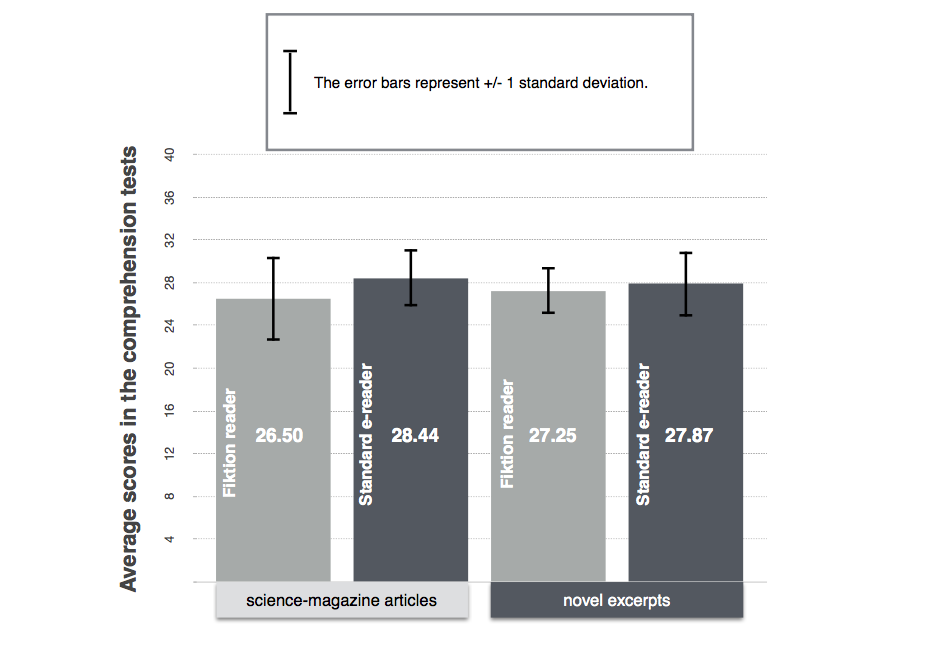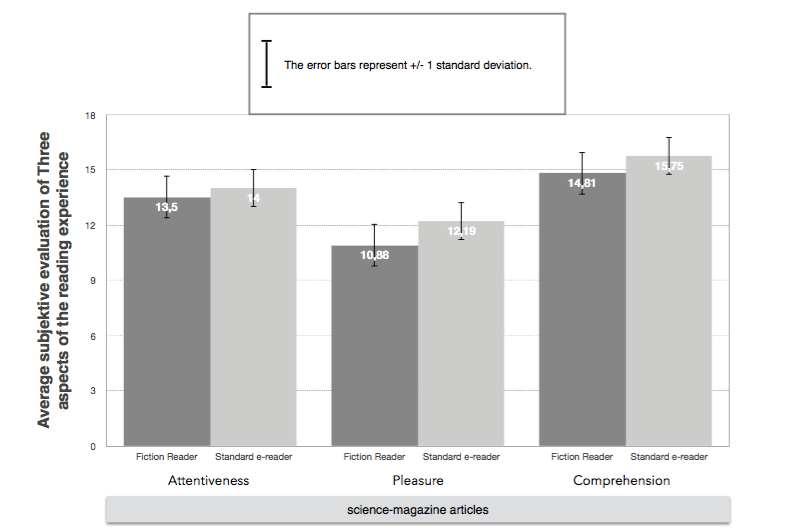15.01.2017
An empirical study of Fiktion’s online reader
Once Fiktion’s newly developed online reader had been successfully used over a longer period of time to present the project’s publications on its website, an experimental study was initiated in spring 2016 in order to examine the reader more closely.
THE STUDY
In a student research project forming part of the B.Sc. psychology course at the Freie Universität Berlin, a group of students conducted a small empirical study in which Fiktion’s reader was compared to a standard e-reader. The study was intended to focus on two questions:
(1) Does the presentation format (reading a text with a standard e-reader or with the Fiktion reader) have a measurable effect on the experience of reading?
(2) Is the Fiktion reader especially well suited to literary texts, as its developers intended?
In order to probe these questions, a total of 32 people were invited to the research labs of the Department of Experimental and Neurocognitive Psychology. They were asked to read two different types of text (either two articles from general-interest science magazines, or two excerpts from novels), after which they took a short reading comprehension test made up of eight multiple-choice questions as a way of finding out how well they remembered the information in the texts. Afterwards the participants answered several questions to evaluate their own reading experience. They were asked for their opinion on how attentive they were to the text, how pleasurable they found reading it, and how easy they thought it was to understand its content.
In order to explore the potential effects of the presentation format, the participants read one text on a standard e-reader and the other using the Fiktion reader. On the standard e-reader, texts were presented one page at a time, and the pages were turned by pressing a button. This was unnecessary with the Fiktion reader, since here the text scrolls continuously upwards from below; its speed can be set to match the one’s own reading speed. A short fable gave participants the opportunity to familiarise themselves with the reading device/interface before reading each text. This familiarisation phase lasted just three to four minutes.
To enable an investigation of the second question, the students selected texts in different linguistic registers. Of the 32 participants, 16 read two science-magazine articles. The remaining 16 read two excerpts from Nicholas Evans’s novel The Horse Whisperer. Both excerpts were chosen so that they could function as standalone texts, without overlaps of characters, setting, or plot. Each text was around 1200 words in length, so that it could be displayed on three to four pages on the standard e-reader. The participants needed between five and eight minutes to read a text of this length, depending on their reading speed.
RESULTS
Analysis of the comprehension test showed that overall the participants could remember the information in the science-magazine articles just as well as the information in the novel excerpts. Closer examination of the averages in Figure 1 reveals that participants remembered more from reading a text on the standard e-reader rather than the Fiktion reader. This divergence was particularly prominent with the science-magazine articles, while it barely made a difference with the novel excerpts. Statistical evaluation of the data with the help of an ANOVA (analysis of variance), however, showed that the difference between both reading interfaces, independently of the type of text, was of marginal significance. The differences should thus be interpreted as a trend and cannot be considered substantive. Testing the effect of the presentation format separately for the science-magazine articles and the novel excerpts does not produce statistically significant results. The differences shown in the chart are thus more random variations. It should be noted, however, that the data from only 16 participants was available for these specific analyses.

Analysis of the survey questions paints a similar picture. Figure 2 shows the results of the self-evaluation for attentiveness, comprehension and pleasure. Participants were asked to rate each of these three factors on a scale of 1 (low/negligible) to 6 (high/excellent). Attentiveness, comprehension and pleasure were rated more highly with the science-magazine articles than the novel excerpts. Moreover, it became clear that the self-evaluations for reading on the standard e-reader were more positive than for reading using the Fiktion reader. The standard e-reader had a particularly clear advantage as concerns the science-magazine articles. In the novel excerpts the divergence between the two presentation formats was markedly smaller.

Statistical evaluation of the data shows that the difference between the type of text in all three categories is significant. It is beyond statistical doubt that the participants reported greater attentiveness, better comprehension and more pleasure when reading the science-magazine articles. Testing the differences between the presentation formats separately for the science-magazine articles and the novel excerpts reveals a murkier picture. The differences for the categories attentiveness and comprehension are not statistically significant for either type of text. The difference as concerns the evaluation of pleasure is, however, significant for both types of text. The participants reported greater pleasure when reading both science-magazine articles and the novel excerpts on a standard e-reader.
CONCLUSIONS
What conclusions could the students draw from the results in relation to the questions cited at the outset?
The results of the comprehension test and the self-evaluation of the participants regarding the experience of reading show that it is certainly affected by the presentation format. For science-magazine articles, above all, the standard e-reader had an advantage over the Fiktion reader. The participants tended to remember more details and above all experienced greater pleasure when reading on the standard e-reader. But that does not mean one should conclude that the Fiktion reader is less well suited for reading. The differences between the results for the two reading interfaces could equally be explained by the familiarity of standard e-readers and/or a lack of familiarity with the Fiktion reader. Future studies should therefore incorporate a longer familiarisation phase, in order to allow participants to get to know the Fiktion reader better and to get closer to putting it on an equal footing through their being more accustomed to using it. It is conspicuous that the differences between the reading interfaces were significantly smaller when participants were reading the novel excerpts. The creators of the Fiktion reader developed it explicitly for reading longer literary texts. The fact that in this study the apparent drawbacks of the Fiktion reader were significantly diminished when reading short literary texts could also be seen as an initial indication of the correctness of the assumption that new reading formats can improve the reader’s capacity to pay attention to a text. Further studies will be necessary to ascertain whether the Fiktion reader offers advantages – in the form of greater reading pleasure combined with more powerful immersive experiences – for reading longer literary texts.